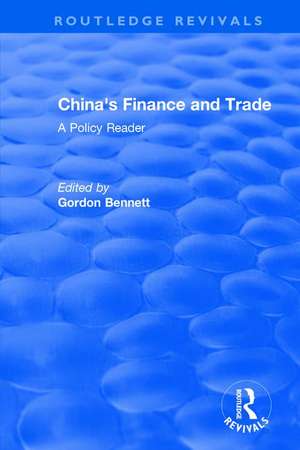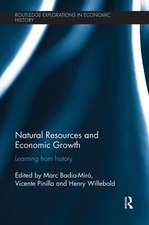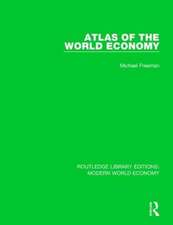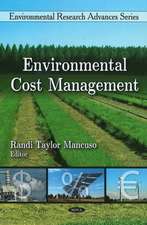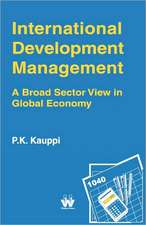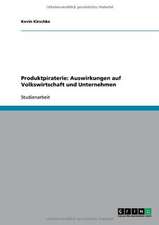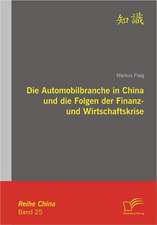Reival: China's Finance and Trade: A Policy Reader (1978): A Policy Reader: Routledge Revivals
Autor Gordon A. Bennetten Limba Engleză Paperback – 25 ian 2019
| Toate formatele și edițiile | Preț | Express |
|---|---|---|
| Paperback (1) | 389.38 lei 6-8 săpt. | |
| Taylor & Francis – 25 ian 2019 | 389.38 lei 6-8 săpt. | |
| Hardback (1) | 1000.27 lei 6-8 săpt. | |
| Taylor & Francis – 13 iul 2017 | 1000.27 lei 6-8 săpt. |
Din seria Routledge Revivals
- 9%
 Preț: 801.69 lei
Preț: 801.69 lei - 8%
 Preț: 432.15 lei
Preț: 432.15 lei -
 Preț: 153.81 lei
Preț: 153.81 lei -
 Preț: 230.80 lei
Preț: 230.80 lei -
 Preț: 294.72 lei
Preț: 294.72 lei -
 Preț: 258.72 lei
Preț: 258.72 lei - 9%
 Preț: 764.34 lei
Preț: 764.34 lei - 9%
 Preț: 903.41 lei
Preț: 903.41 lei -
 Preț: 296.10 lei
Preț: 296.10 lei -
 Preț: 342.36 lei
Preț: 342.36 lei - 9%
 Preț: 606.35 lei
Preț: 606.35 lei -
 Preț: 317.54 lei
Preț: 317.54 lei - 9%
 Preț: 764.28 lei
Preț: 764.28 lei -
 Preț: 257.00 lei
Preț: 257.00 lei -
 Preț: 238.40 lei
Preț: 238.40 lei -
 Preț: 259.47 lei
Preț: 259.47 lei - 9%
 Preț: 903.80 lei
Preț: 903.80 lei -
 Preț: 326.26 lei
Preț: 326.26 lei -
 Preț: 258.66 lei
Preț: 258.66 lei -
 Preț: 294.97 lei
Preț: 294.97 lei -
 Preț: 308.89 lei
Preț: 308.89 lei -
 Preț: 199.85 lei
Preț: 199.85 lei -
 Preț: 347.49 lei
Preț: 347.49 lei -
 Preț: 295.04 lei
Preț: 295.04 lei -
 Preț: 389.39 lei
Preț: 389.39 lei -
 Preț: 257.00 lei
Preț: 257.00 lei -
 Preț: 343.21 lei
Preț: 343.21 lei - 9%
 Preț: 640.90 lei
Preț: 640.90 lei - 9%
 Preț: 619.48 lei
Preț: 619.48 lei -
 Preț: 228.88 lei
Preț: 228.88 lei -
 Preț: 257.67 lei
Preț: 257.67 lei -
 Preț: 245.10 lei
Preț: 245.10 lei -
 Preț: 258.52 lei
Preț: 258.52 lei -
 Preț: 258.72 lei
Preț: 258.72 lei -
 Preț: 368.93 lei
Preț: 368.93 lei -
 Preț: 246.37 lei
Preț: 246.37 lei - 9%
 Preț: 832.07 lei
Preț: 832.07 lei -
 Preț: 258.66 lei
Preț: 258.66 lei -
 Preț: 286.98 lei
Preț: 286.98 lei - 18%
 Preț: 695.85 lei
Preț: 695.85 lei - 9%
 Preț: 934.94 lei
Preț: 934.94 lei - 5%
 Preț: 231.22 lei
Preț: 231.22 lei -
 Preț: 267.15 lei
Preț: 267.15 lei -
 Preț: 200.66 lei
Preț: 200.66 lei - 9%
 Preț: 638.61 lei
Preț: 638.61 lei -
 Preț: 259.68 lei
Preț: 259.68 lei - 9%
 Preț: 1038.45 lei
Preț: 1038.45 lei -
 Preț: 389.43 lei
Preț: 389.43 lei -
 Preț: 302.13 lei
Preț: 302.13 lei -
 Preț: 302.25 lei
Preț: 302.25 lei
Preț: 389.38 lei
Nou
Puncte Express: 584
Preț estimativ în valută:
74.51€ • 78.01$ • 61.80£
74.51€ • 78.01$ • 61.80£
Carte tipărită la comandă
Livrare economică 09-23 aprilie
Preluare comenzi: 021 569.72.76
Specificații
ISBN-13: 9781138045071
ISBN-10: 1138045071
Pagini: 264
Dimensiuni: 156 x 234 x 14 mm
Greutate: 0.45 kg
Ediția:1
Editura: Taylor & Francis
Colecția Routledge
Seria Routledge Revivals
Locul publicării:Oxford, United Kingdom
ISBN-10: 1138045071
Pagini: 264
Dimensiuni: 156 x 234 x 14 mm
Greutate: 0.45 kg
Ediția:1
Editura: Taylor & Francis
Colecția Routledge
Seria Routledge Revivals
Locul publicării:Oxford, United Kingdom
Cuprins
Part 1: General Economic Line 1. People's Daily: Correspondent Prescribes two opposed Lines for Building the Economy 2. Red Flag: Author Argues Politics is a Concentrated Manifestation of Economics 3. Revolutionary Mass Criticism groups Denounce Sun Yeh-fang's "One Black Program" and " Five Soft Daggera" 4. Revolutionary Mass Criticism Groups Tie Sun Yeh-fang to Liu Shao-ch'i 5. Provincial Revolutionary Committee Writing Group Asserts Sun Yeh-fang's "System of Politcal Economy" Is an Ideological foundation for Liu Shao-ch-i's Counterrevolutionary Line 6. Provincial Revolutionary Committee Writing Group Identifies what Sun Yeh-fang learned from Efsei Liberman 7. Provincial Revolutionary Committee Writing groups Asserts Sun Yeh-fang's Program would serve the interests of the "Eight Immortals" 8. State Planning Commission Writing Group Emphasizes the Importance of Thrift 9. Provincial Revolutionary Committee Writing Group warns putting Politics in command is not enough 10. People's Daily: Correspondent Refutes the Argument "Statistics is Useless" 11 Provincial Revolutionary Committee Writing Team Argues Land, Labor and capital are insufficient to explain Economic Development 12. State Planning Commission Charts the Future of the Chinese Economy in the Post-Mao Era Part 2: Planning and Markets 13. Ministry of Commerce Writing Group Refutes four main Issues in the Two-Line Struggle in Commerce 14. Ministry of Commerce Writing Group contrasts correct Line for Leading Commerce with Liu Shao-ch-i's Line 15.Ministry of Commerce Writing Group refutes Liu Shao Ch-i's Fallacy "Ciculation Determines Production" 16. Ministry of Commerce Writing Group Criticizes Shao-ch-i for Advocating Free Markets 17. Ministry of Commerce Writing Group describes how Liu Shao-ch-i promoted Capitalism in Rural Commerce 18. Provincial Revolutionary Committee Writing Team analyzes the danger of spontaneous Capitalism when diversifying Rural Economics 19. Economist Asserts China's Individual Peasant Economy is basically a Petty Commodiry Economy 20. Economist Analyzes Classes in a Rural Petty Commodity Economy 21. Economist Analyzes Growth of Speculation and Usury after Land Reform 22. Ministry of Commerce Writing Group Charges Liu Shao-Ch-i Advocated "Squeezing" the Peasant Sector 23. Economist Argues that Capitalist Planning is unscientific, unrealiable, and wasteful 24. Economist Lists Necessary Socialist Planning Targets 25. Economist Analyzes Socialist Planning as Continuous Preparations to handle Disquilibria 26. Economist Outlines Fout Main Equilibria Socialist Planning should try to achieve 27. Provincial Revolutionary Committee Writing Group criticizes Sun Yeh-fang's view that "Plans Should be based on the Law of Value" 28. Provincial Revolutionary Committee Writing Group puts the "Law of Value" in Perspective 29. Provincial Revolutionary Committee Writing Group Criticizes Overemphasis on Profits 30. Red Flag: Author Exposes Class Enemies' tactics on the Finance-Trade Front 31. People's Daily: Correspondent urges Commercial department to promote development of a diversified Rural Economy 32. New China News Agency: Correspondent Reports on New-Style Rural Periodic Market where Private Transactions are minimized 33. Representatives of Ten Big Department Stores in Nince cities demounce Ten Hsiao-p'ing and demand "Bourgeois Right" be restricted 34. All-Chinese Supply and Marketing, Co-op mass Criticism Group Exposes Crimes of the "gang of Four" in Sabotaging Agricultural Subsidary Production in Rural Markets. Part 3: Money, Banking, and Investment 35. Economist gives comprehensive overview of Socialist Public Finance 36. Pierre-Henri Cassou, "The Chinese Monetary System" 37. Red Flag: Correspondent reports the advanced experience of a Model Banking Office 38. "Red bank" [Homonym] Lauds the Long-term stability of the Jen-min-pi 39. "Red Bank" draws contest between currencies of China and the Soviet Union's Ruble 40. "Red Bank" draws further contrasts between the Jen-min pi and Currency under the KMT and under the Line of Liu Shao ch-i 41. Red Flag: Author explains why the Jen-min pi has remained stable 42. Economist observes a shift since 1949 in the profile of People Making Personal savings Deposits 43. Economist Reports increase in Proportion of Fixed Savings Deposits to Total Deposits, 1952-1963 44. People's Daily: Correspondent explains Continued Increase in savings Deposits through 1973 45. Economist explains the importance of People's Savings to Economic Construction 46. Economist raises the Problem of Ratio of Accumulation to Consumption in Rural Communes 47. Economist Detail three Attributes of the Accumulation/Consumption Ratio 48. Economist Notes Relationship between Consumption and Labor Productivity 49. Economist Identifies Views of the Accumulation/Consumption ratio held by different Rural Classes 50. Economist refutes view that Accumulation/Consumption Ratio should remain stable 51. Mao Tse-tung Legitimizes Interests of State Collective, and Individual 52. Economist Notes how Bumper harvest Years and Lean Years should affect Accumulation/Consumption Ratio 53. Province and Ministry of Light Industry Joint Investigation Group argues for "Multiple Utilization" to reduce waste 54. Group of Theorists at a Branch of the People's Bank discusses importance of Money in a Socialist Economy 55. Theory Group at a District Office of the People's bank discusses Money and Exchange in a Socialist Economy 56. People's Daily: Correspondent reports on the Supervisory function of a People's Bank Office
Descriere
For students of politics the documents in this collection offer an opportunity to analyze a broad policy area - finance and commerce - in search of specific mechanisms by which dictatorship and popular will are both given expression in political life.
